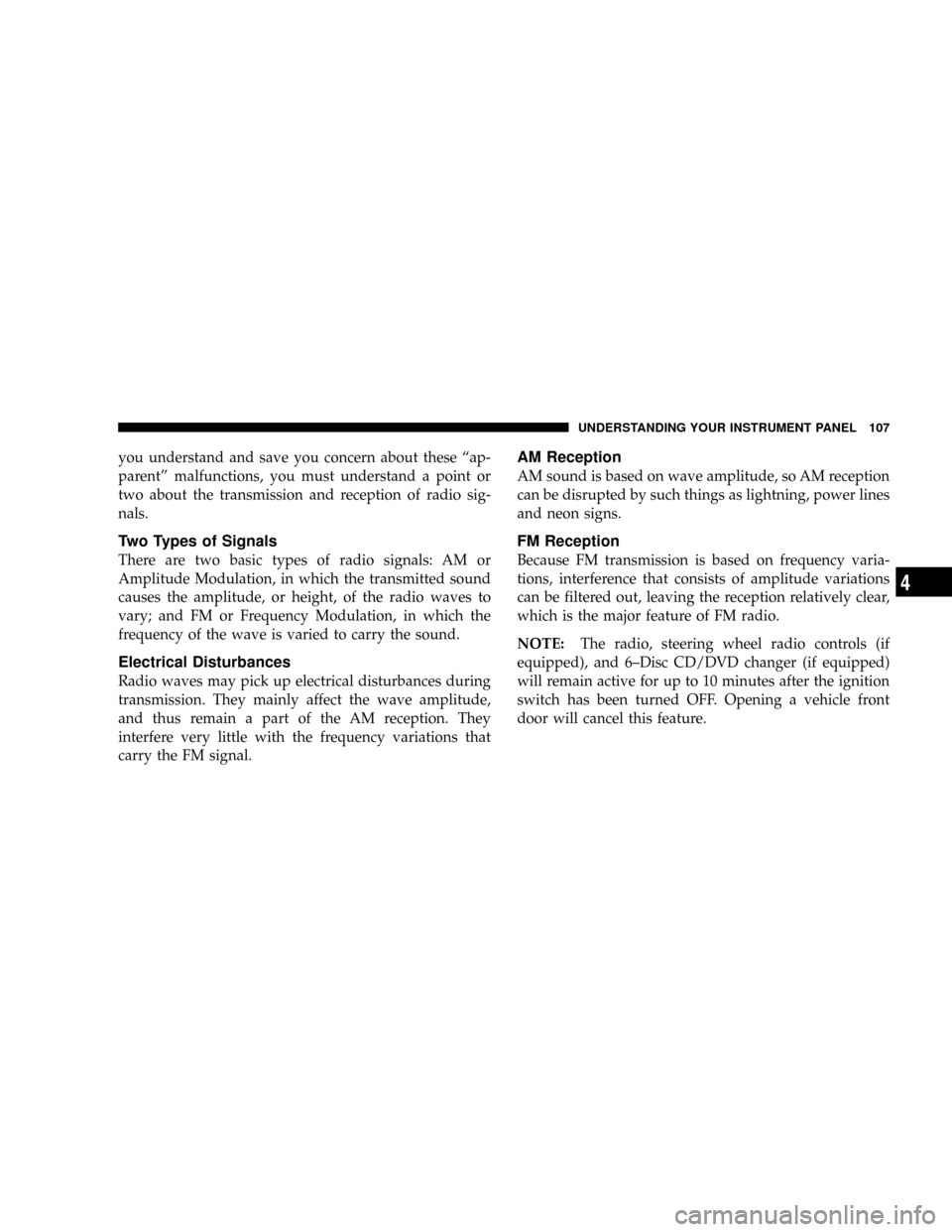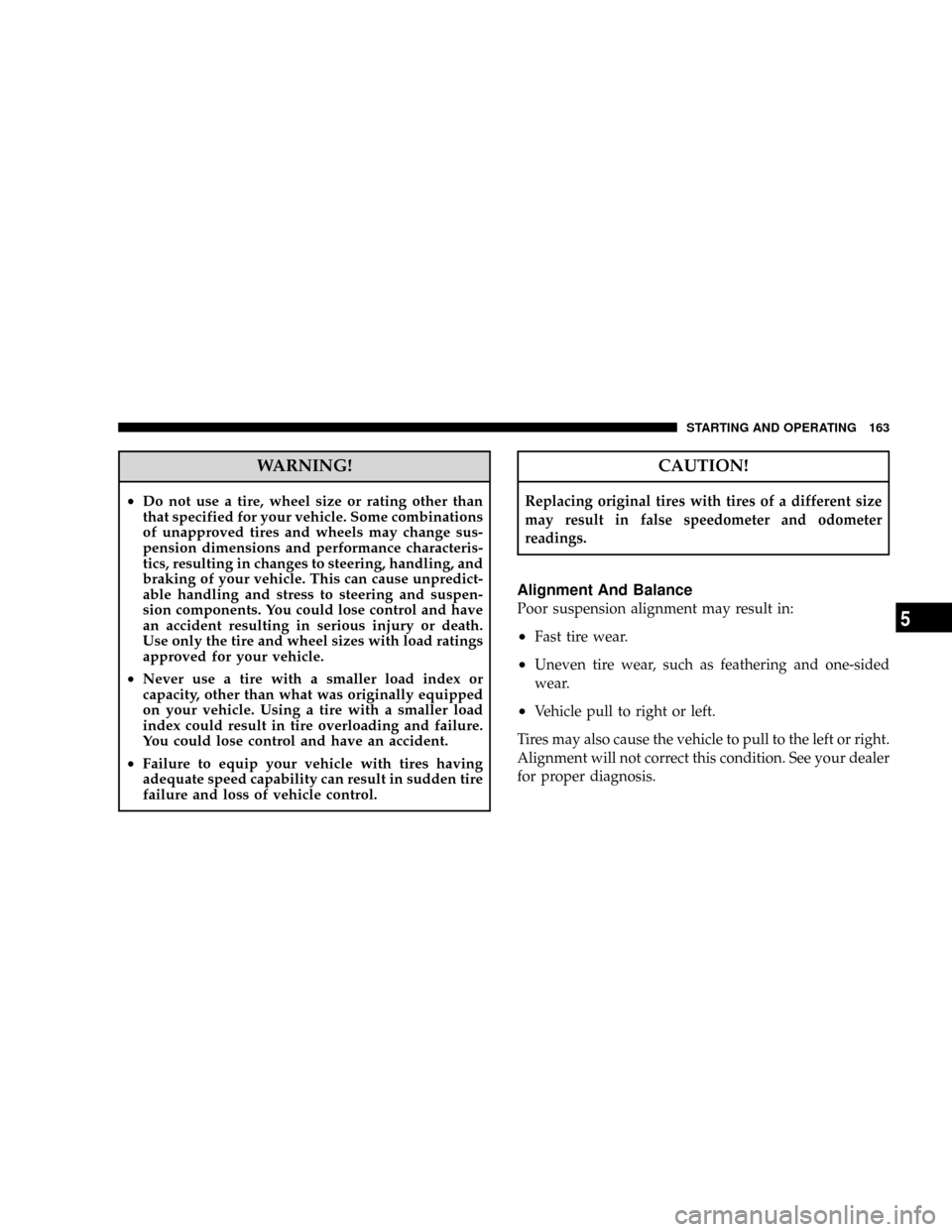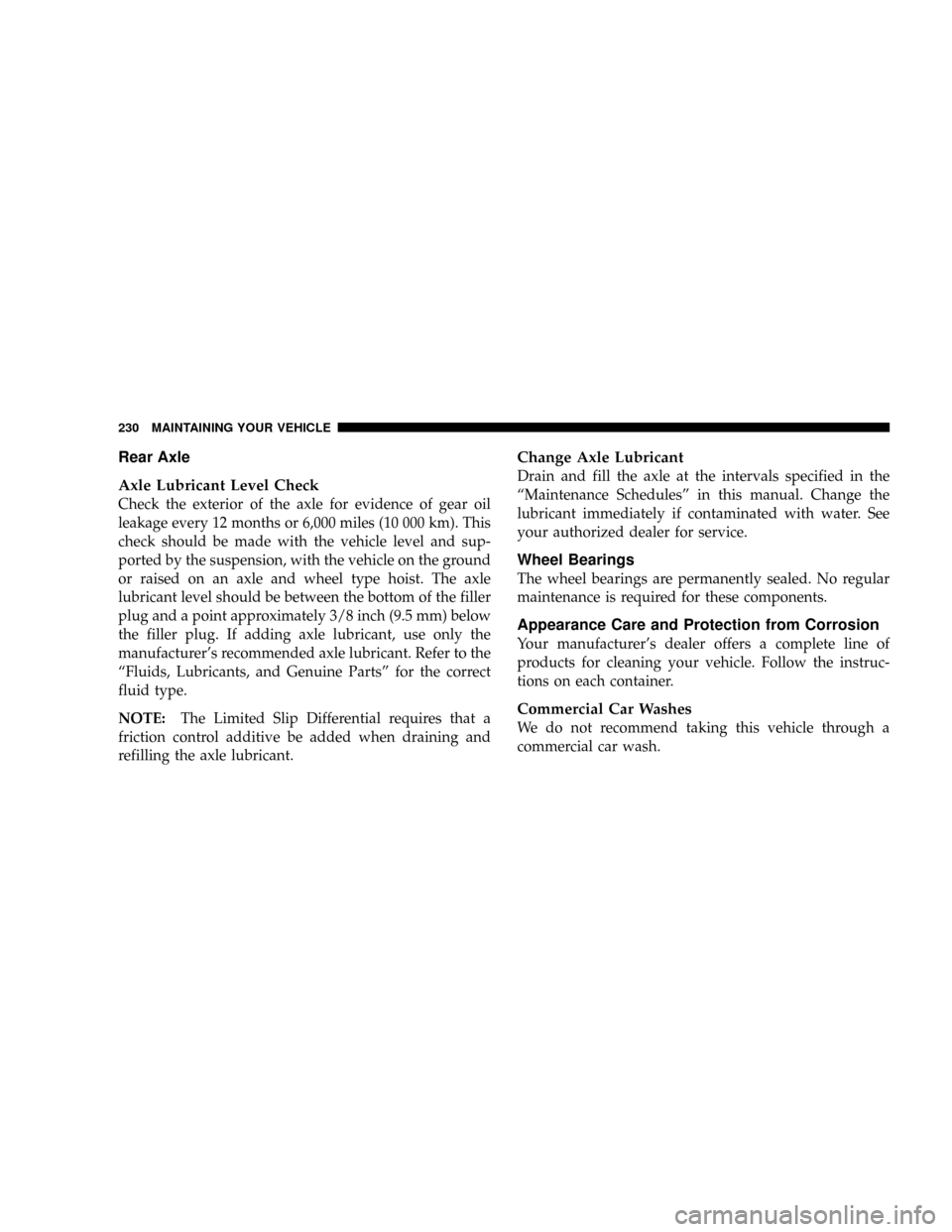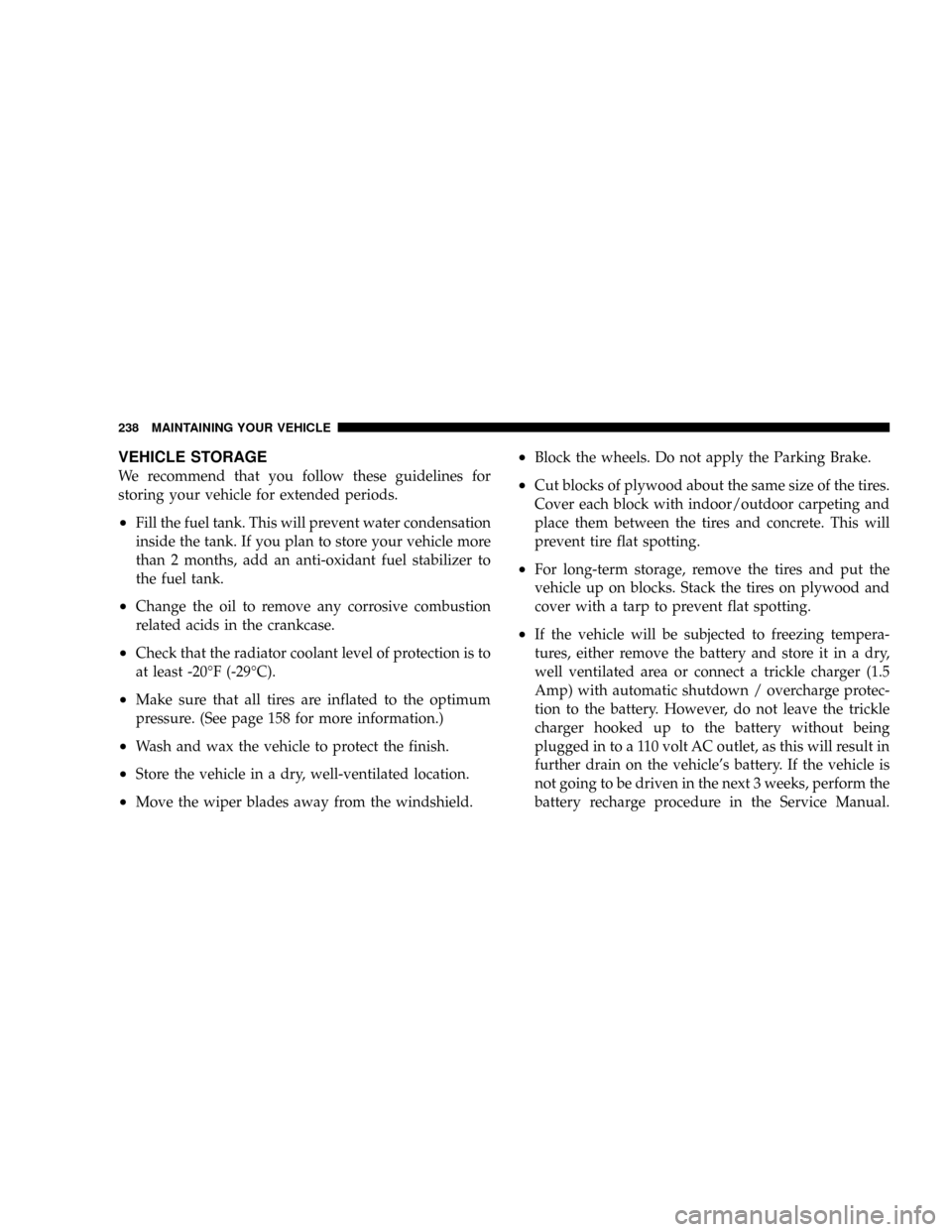change wheel DODGE VIPER 2008 ZB II / 2.G Owners Manual
[x] Cancel search | Manufacturer: DODGE, Model Year: 2008, Model line: VIPER, Model: DODGE VIPER 2008 ZB II / 2.GPages: 303, PDF Size: 2.65 MB
Page 108 of 303

you understand and save you concern about these ªap-
parentº malfunctions, you must understand a point or
two about the transmission and reception of radio sig-
nals.
Two Types of Signals
There are two basic types of radio signals: AM or
Amplitude Modulation, in which the transmitted sound
causes the amplitude, or height, of the radio waves to
vary; and FM or Frequency Modulation, in which the
frequency of the wave is varied to carry the sound.
Electrical Disturbances
Radio waves may pick up electrical disturbances during
transmission. They mainly affect the wave amplitude,
and thus remain a part of the AM reception. They
interfere very little with the frequency variations that
carry the FM signal.
AM Reception
AM sound is based on wave amplitude, so AM reception
can be disrupted by such things as lightning, power lines
and neon signs.
FM Reception
Because FM transmission is based on frequency varia-
tions, interference that consists of amplitude variations
can be filtered out, leaving the reception relatively clear,
which is the major feature of FM radio.
NOTE:The radio, steering wheel radio controls (if
equipped), and 6±Disc CD/DVD changer (if equipped)
will remain active for up to 10 minutes after the ignition
switch has been turned OFF. Opening a vehicle front
door will cancel this feature.
UNDERSTANDING YOUR INSTRUMENT PANEL 107
4
Page 164 of 303

WARNING!
²Do not use a tire, wheel size or rating other than
that specified for your vehicle. Some combinations
of unapproved tires and wheels may change sus-
pension dimensions and performance characteris-
tics, resulting in changes to steering, handling, and
braking of your vehicle. This can cause unpredict-
able handling and stress to steering and suspen-
sion components. You could lose control and have
an accident resulting in serious injury or death.
Use only the tire and wheel sizes with load ratings
approved for your vehicle.
²Never use a tire with a smaller load index or
capacity, other than what was originally equipped
on your vehicle. Using a tire with a smaller load
index could result in tire overloading and failure.
You could lose control and have an accident.
²Failure to equip your vehicle with tires having
adequate speed capability can result in sudden tire
failure and loss of vehicle control.
CAUTION!
Replacing original tires with tires of a different size
may result in false speedometer and odometer
readings.
Alignment And Balance
Poor suspension alignment may result in:
²Fast tire wear.
²Uneven tire wear, such as feathering and one-sided
wear.
²Vehicle pull to right or left.
Tires may also cause the vehicle to pull to the left or right.
Alignment will not correct this condition. See your dealer
for proper diagnosis.
STARTING AND OPERATING 163
5
Page 231 of 303

Rear Axle
Axle Lubricant Level Check
Check the exterior of the axle for evidence of gear oil
leakage every 12 months or 6,000 miles (10 000 km). This
check should be made with the vehicle level and sup-
ported by the suspension, with the vehicle on the ground
or raised on an axle and wheel type hoist. The axle
lubricant level should be between the bottom of the filler
plug and a point approximately 3/8 inch (9.5 mm) below
the filler plug. If adding axle lubricant, use only the
manufacturer's recommended axle lubricant. Refer to the
ªFluids, Lubricants, and Genuine Partsº for the correct
fluid type.
NOTE:The Limited Slip Differential requires that a
friction control additive be added when draining and
refilling the axle lubricant.
Change Axle Lubricant
Drain and fill the axle at the intervals specified in the
ªMaintenance Schedulesº in this manual. Change the
lubricant immediately if contaminated with water. See
your authorized dealer for service.
Wheel Bearings
The wheel bearings are permanently sealed. No regular
maintenance is required for these components.
Appearance Care and Protection from Corrosion
Your manufacturer's dealer offers a complete line of
products for cleaning your vehicle. Follow the instruc-
tions on each container.
Commercial Car Washes
We do not recommend taking this vehicle through a
commercial car wash.
230 MAINTAINING YOUR VEHICLE
Page 239 of 303

VEHICLE STORAGE
We recommend that you follow these guidelines for
storing your vehicle for extended periods.
²Fill the fuel tank. This will prevent water condensation
inside the tank. If you plan to store your vehicle more
than 2 months, add an anti-oxidant fuel stabilizer to
the fuel tank.
²Change the oil to remove any corrosive combustion
related acids in the crankcase.
²Check that the radiator coolant level of protection is to
at least -20ÉF (-29ÉC).
²Make sure that all tires are inflated to the optimum
pressure. (See page 158 for more information.)
²Wash and wax the vehicle to protect the finish.
²Store the vehicle in a dry, well-ventilated location.
²Move the wiper blades away from the windshield.
²Block the wheels. Do not apply the Parking Brake.
²Cut blocks of plywood about the same size of the tires.
Cover each block with indoor/outdoor carpeting and
place them between the tires and concrete. This will
prevent tire flat spotting.
²For long-term storage, remove the tires and put the
vehicle up on blocks. Stack the tires on plywood and
cover with a tarp to prevent flat spotting.
²If the vehicle will be subjected to freezing tempera-
tures, either remove the battery and store it in a dry,
well ventilated area or connect a trickle charger (1.5
Amp) with automatic shutdown / overcharge protec-
tion to the battery. However, do not leave the trickle
charger hooked up to the battery without being
plugged in to a 110 volt AC outlet, as this will result in
further drain on the vehicle's battery. If the vehicle is
not going to be driven in the next 3 weeks, perform the
battery recharge procedure in the Service Manual.
238 MAINTAINING YOUR VEHICLE